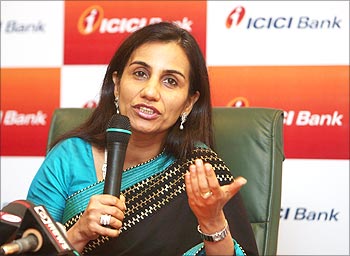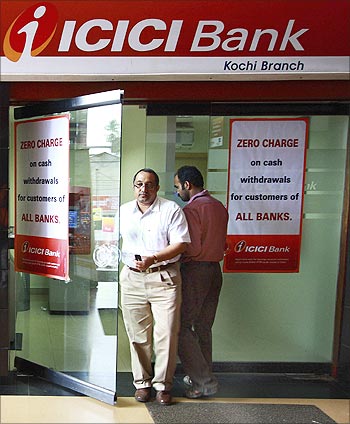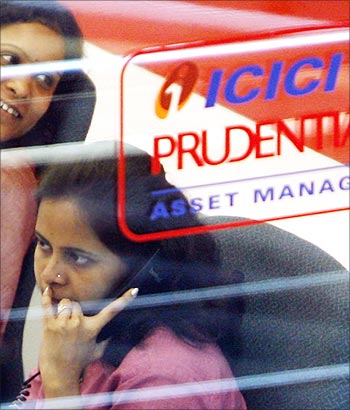
The Year 2009 saw a lot of activity in the banking sector: Most banks were seen reducing interest rates on loans, while many were shying away from risky corporate accounts in light of global financial crisis.
But still, most banks' performance was commendable and profit figures were admirable, given the fact that most foreign banks, especially in the United States, were closing down.
We bring you a series on how some of the top banks in India performed during the Year 2009 and how they are positioned for the coming year. Read on. . .
ICICI Bank
ICICI Bank is the second largest bank in India (SBI is the largest). It offers a wide range of banking products and financial services to corporate and retail customers through a variety of delivery channels and through its specialised subsidiaries and affiliates in the areas of investment banking, life and non-life insurance, venture capital and asset management.
The bank currently has subsidiaries in the United Kingdom, Russia and Canada; branches in the United States, Singapore, Bahrain, Hong Kong, Sri Lanka, Qatar and Dubai International Finance Centre and representative offices in United Arab Emirates, China, South Africa, Bangladesh, Thailand, Malaysia and Indonesia. The bank's UK subsidiary has established branches in Belgium and Germany.
ICICI bank's equity shares are listed in India on Bombay Stock Exchange and the National Stock Exchange and its American Depositary Receipts (ADRs) are listed on the New York Stock Exchange (NYSE).
Year 2009 for ICICI Bank
ICICI Bank had total assets worth Rs 366,374 crore (Rs 3,663.74 billion) at end-September 2009. The bank recorded a profit after tax of Rs 1,040 crore (Rs 10.40 billion) for the quarter ended September 30, 2009, a sequential increase of 18 per cent from Rs 878 crore (Rs 8.78 billion) in the quarter ended June 30, 2009.
As on October 26, 2009, the bank's branch network stood at 1,520 and number of ATM's in India at about 4,816. It had presence in 18 countries by this date.
The bank is in the process of implementing the 580 branch licenses received from Reserve bank of India which would expand its network to about 2,100 branches, giving the bank a wide distribution reach in the country.
Performance summary
The bank's profit before tax for FY2009 stood Rs 5,117 crore (Rs 51.17 billion) compared with Rs 5,056 crore (Rs 50.56 billion) in FY2008.
Profit after tax for FY2009 was Rs 3,758 crore (Rs 37.58 billion) compared to Rs 4,158 crore (Rs 41.58 billion) for FY2008 due to the higher effective tax rate on account of lower proportion of income taxable as dividends and capital gains. The bank reported an increase in treasury gains, though the core banking income was slightly below expectations. . . .

Reduced expenses
Operating expense is an ongoing cost for running a product, business. The objective of any organisation is to minimise its operating cost at the same time gain market share. ICICI Bank has succeeded in this aspect; the operating expenses (including direct marketing agency expenses) decreased 14 per cent to Rs 6,835 crore (Rs 68.35 billion) in FY2009 from Rs 7,972 crore (Rs 79.72 billion) in FY2008.
Lending activities
The main banking function is to accept deposits and lend money. Most of the aggressive loan sales departments of the bank were operating at lesser operating and manpower levels due to a strategic slow down policy. This has helped the bank to reduce the increase in the Non-Performing Assets (NPA).
The bank had gone slow on its housing loans, mortgage loans and automobiles loans (both 2 wheelers and 4 wheelers). Most of the automobile showrooms did not have an ICICI Bank representative throughout the year. ICICI Bank was also the last among the major banks to reduce the housing loan interest rate to the competitive 8.5 per cent. Most of the PSU banks lead by SBI were offering this rate since the beginning of the year 2009.
The going slow on the lending has helped the bank to have a better portfolio of assets. This will help the bank in the years to come.
Deposit base
ICICI has witnessed an increase in deposit base by Rs 9,283 crore (Rs 92.83 billion) in fourth quarter of 2009, of which Rs 5,286 crore (Rs 52.86 billion) was CASA (current account and savings account). CASA ratio is the ratio of the deposits in the form of current account & savings account to the total deposits. There was a substantial increase in CASA ratio of the bank to 28.7 per cent at end-March, 2009 compared to 27.4 per cent at end-December, 2008 and 26.1 per cent at end-March, 2008.

Net interest income
All firms can divide the balance sheet into assets and liabilities. For banks the assets are commercial and personal loans, mortgages, construction loans and securities. The liabilities are deposits from customers. The net interest income (NII) is then the difference between the revenues on the assets and the cost of servicing the liabilities. There was a 15 per cent increase in net interest income of the bank from Rs 7,304 crore (Rs 73.04 billion) in FY2008 to Rs 8,367 crore (Rs 83.67 billion) in FY2009.
Performance of subsidiaries
ICICI Bank has a good portfolio of subsidiaries. Some of them have good revenue streams; others have a good market value which could be tapped strategically to make capital gains.
Insurance Subsidiaries
ICICI Prudential Life Insurance Company (ICICI Life) maintained its position as the largest private sector life insurer based on retail new business weighted received premium during the quarter year ended September 30, 2009. ICICI Life's total premium in quarter was Rs 3,634 crore (Rs 36.34 billion).
ICICI Life's renewal premium upto September-2009 increased by 28 per cent compared to 2008, reflecting the long term sustainability of the business. This company is yet to make any profit.
ICICI Lombard General Insurance Company (ICICI General) maintained its leadership in the private sector during the half year ended September 30, 2009. ICICI General's premium in the second quarter of 2009 was Rs 801 crore (Rs 8.01 billion). ICICI General's profit after tax for the second quarter of 2009 was Rs 51 crore (Rs 510 million).

ICICI Prudential Asset Management Company's profit after tax for the quarter ending September 2009 was Rs 48 crore compared to Rs 16 crore ($3 million) in the same quarter last year. ICICI Securities' profit after tax for the second quarter of 2009 was Rs 38 crore ($8 million) compared to Rs 10 crore ($2 million) in the same quarter in 2008.
3i Info Systems
The holding of the bank in this software subsidiary was recently sold for a good price, yielding the bank about Rs 900 crores (Rs 9.0 billion) in cash. This benefit will be reflected in the quarterly report ending December 2009.
Summary
With the strategies of stringent cost control measures, maintaining strong capital adequacy, the bank will be well positioned for a better performance in 2010. By that time there are more possibilities for the macro environment to recover from the global slowdown, helping the bank further.
The bank has won The Asset Triple A Country Awards for Best Domestic Bank in India.
Also, at the leadership position, Chanda Kochar is proving her mettle and has further enhanced the vision of the bank.
Stay tuned as we bring you the 2009 performances of more banks.